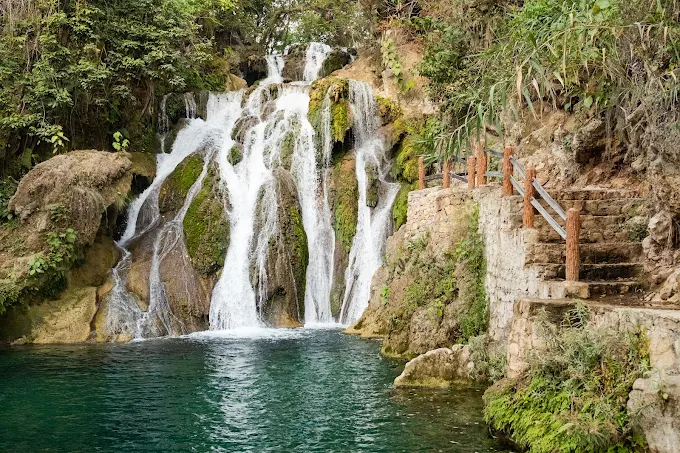Explore the Region
The Jewel of Eastern Mexico
The Huasteca Potosina is a region of extraordinary natural beauty located in the eastern part of the state of San Luis Potosí, Mexico. Known for its stunning waterfalls, turquoise rivers, and lush tropical landscapes, it offers visitors an unforgettable experience with its combination of natural wonders and cultural heritage.
This region is characterized by its abundant water resources, including rivers, lakes, and cascades that have carved a landscape of incredible beauty through limestone formations. The region's tropical climate nurtures a rich biodiversity, making it one of Mexico's most ecologically significant areas.





Must-Visit Destinations
During your visit for the Xantolo Handball Festival, these iconic destinations should be at the top of your list. We've included the distance from Ciudad Valles to help you plan your trip efficiently:
 87 km from Ciudad Valles
87 km from Ciudad Valles
Tamul Waterfall
Mexico's most spectacular waterfall with a 105-meter drop creating a breathtaking turquoise pool. The boat journey to the waterfall through the canyons is an adventure in itself.
 78 km from Ciudad Valles
78 km from Ciudad Valles
Las Pozas Surrealist Garden
Edward James' dreamlike concrete sculptures set in the lush rainforest of Xilitla create a surreal atmosphere where art meets wild nature. The structures seem to defy both gravity and logic.
 25 km from Ciudad Valles
25 km from Ciudad Valles
Micos Waterfalls
A series of seven cascades forming natural pools perfect for swimming and natural water slides. This is the closest major attraction to Ciudad Valles and perfect for a quick adventure.
 62 km from Ciudad Valles
62 km from Ciudad Valles
Puente de Dios (God's Bridge)
A spectacular natural limestone bridge with crystal-clear turquoise waters and magical light effects when sunbeams penetrate through the cave opening, creating an otherworldly blue glow.
 97 km from Ciudad Valles
97 km from Ciudad Valles
Sótano de las Golondrinas
One of the largest cave shafts in the world at 372 meters deep. The magical spectacle occurs at dawn and dusk when thousands of swifts and green parakeets spiral in and out of the cave in a tornado-like formation.
 55 km from Ciudad Valles
55 km from Ciudad Valles
Tamasopo Waterfalls
Three beautiful cascades surrounded by tropical forest with jade-colored pools perfect for swimming. The well-developed facilities make this site family-friendly and more accessible than other waterfalls.
Local Cuisine: Must-Try Dishes
The Huasteca region is known for its distinctive culinary traditions that blend indigenous and Spanish influences:
Zacahuil
The king of tamales! This enormous corn masa creation can reach up to 3 meters long and is filled with pork or chicken marinated in a red chile sauce, wrapped in banana leaves, and slow-cooked in a wood-fired earth oven.
Where to try it: Mercado Municipal in Ciudad Valles or roadside stands on weekends
Bocoles
Thick, handmade corn tortillas often stuffed with cheese, beans, or chicharrón (pork rinds). They're a staple breakfast item throughout the region and perfect for fueling up before matches.
Where to try it: Most local restaurants serve these for breakfast
Cecina Huasteca
Thinly sliced, sun-dried beef marinated in citrus and chiles, then grilled and served with fresh garnishes. The meat is incredibly tender and full of flavor.
Where to try it: Look for "cecina" specialists in Ciudad Valles
Practical Information
Before visiting the Huasteca Potosina during your tournament stay, here's some essential information to help you prepare:
Climate & Weather
The Huasteca region has a warm, humid climate throughout most of the year:
Dry Season (November-April): Pleasant temperatures (20-30°C) with less rainfall. Waterfalls may have lower water volumes but are still impressive.
Rainy Season (May-October): Hot temperatures (25-35°C) with afternoon showers. Waterfalls are at their most spectacular, but flash floods can occasionally affect accessibility.
Safety Tips
The Huasteca Potosina is generally safe for tourists, but it's always good to take some precautions:
- Always go with certified guides for adventure activities
- Use life jackets for all water activities (even if you're a strong swimmer)
- Apply biodegradable sunscreen to protect yourself and the environment
- Stay hydrated – the humidity can be deceptive
- Don't adventure alone in remote areas
- Keep valuables secure and use hotel safes when available
What to Pack
For your adventures in the Huasteca region, these items are essential:
- Quick-dry clothing and swimwear
- Water shoes with good grip (for waterfall and river activities)
- Biodegradable insect repellent
- Light rain jacket or poncho
- Dry bag for electronics and valuables
- Reusable water bottle
- Small backpack for day trips
Responsible Tourism
The Huasteca Potosina is an ecologically sensitive region. As visitors, we can help preserve its beauty by:
- Using biodegradable sunscreen and toiletries
- Carrying out all trash
- Staying on designated trails
- Supporting local businesses and communities
- Respecting indigenous customs and traditions
Special Thanks
We would like to extend our heartfelt gratitude to Melinda Ignácz, whose stunning photography captures the breathtaking beauty of the Huasteca Potosina region. The majority of the images featured on this website were taken by Linda, whose artistic vision and dedication have helped us showcase this magnificent destination in all its glory.